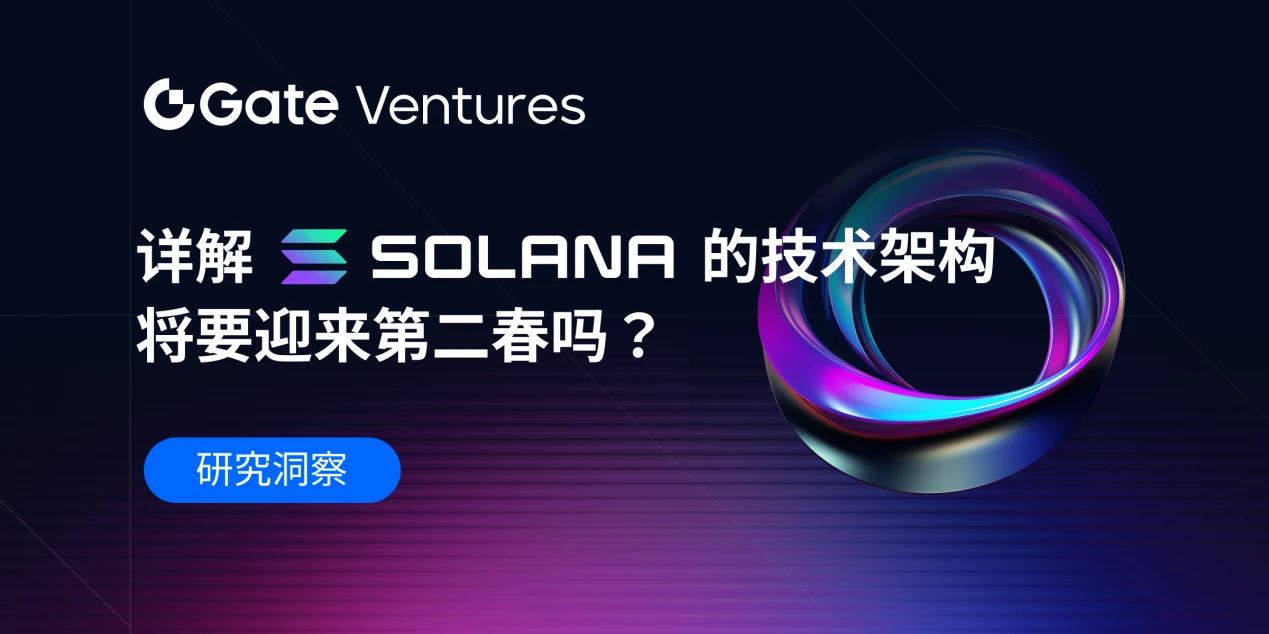
Summary
Solana is a high-performance blockchain platform that achieves high throughput and low latency through its unique technical architecture. Its core technologies include the Proof of History (POH) algorithm to ensure transaction order and global clock, Leader Rotation Schedule, and Tower BFT consensus mechanism to increase block production rate. The Turbine mechanism optimizes large block propagation through Reed-Solomon encoding. The Solana Virtual Machine (SVM) and Sealevel parallel execution engine accelerate transaction execution speed. These are all architectural designs that enable Solana to achieve high performance, but they also bring some issues such as network downtime, transaction failures, MEV issues, rapid state growth, and centralization, which we also emphasize in this article.
Solana's ecosystem is developing rapidly, with various data indicators experiencing rapid growth in the first half of the year, especially in the areas of DeFi, infrastructure, GameFi/NFT, DePin/AI, and consumer applications. Solana's high TPS and its strategic focus on consumer applications, as well as its relatively weak brand effect in the ecosystem, provide abundant entrepreneurial opportunities for entrepreneurs and developers. In terms of consumer applications, Solana has demonstrated its vision for promoting the application of blockchain technology in a wider range of fields. By supporting applications such as Solana Mobile and SDKs specifically designed for consumer applications, Solana is committed to integrating blockchain technology into daily applications to improve user acceptance and convenience. For example, applications like Stepn provide users with novel fitness and social experiences by combining blockchain and mobile technology. Although many consumer applications are still exploring the best business models and market positioning, Solana's technical platform and ecosystem support undoubtedly provide strong backing for these innovative attempts. With further technological development and market maturity, Solana is expected to achieve more breakthroughs and successful cases in the consumer application field.
Although Solana has gained significant market share in the blockchain industry due to its high throughput and low transaction costs, it also faces fierce competition from other emerging public chains. Base, as a potential competitor in the EVM ecosystem, has seen a rapid increase in on-chain active addresses, and while Solana's total value locked (TVL) in the DeFi sector has reached a historic high, competitors such as Base are also rapidly gaining market share, with Base's ecosystem financing volume surpassing Solana's for the first time in the second quarter.
Despite achieving certain achievements in technology and market acceptance, Solana needs to continue to innovate and improve to address challenges from competitors such as Base. In particular, in improving network stability, reducing transaction failure rates, addressing MEV issues, and slowing down the growth rate of the state, Solana needs to continuously optimize its technical architecture and network protocols to maintain its leading position in the blockchain industry.
Technical Architecture
Solana is known for its high TPS and fast finality brought by its POH algorithm, Tower BFT consensus mechanism, Trubine data transmission network, and SVM virtual machine. We will briefly introduce how each component works, how it achieves its high-performance goals for architectural design, and the drawbacks and problems derived from this architectural design.
POH Algorithm
POH (Proof of History) is a technology for determining global time, which is not a consensus mechanism but an algorithm for determining transaction order. The POH technology originates from the most basic cryptography SHA256 technology. SHA256 is commonly used to calculate data integrity. Given an input X, there is only one unique output Y, so any change to X will result in a completely different Y.

POH sequence, image source: Solana Whitepaper
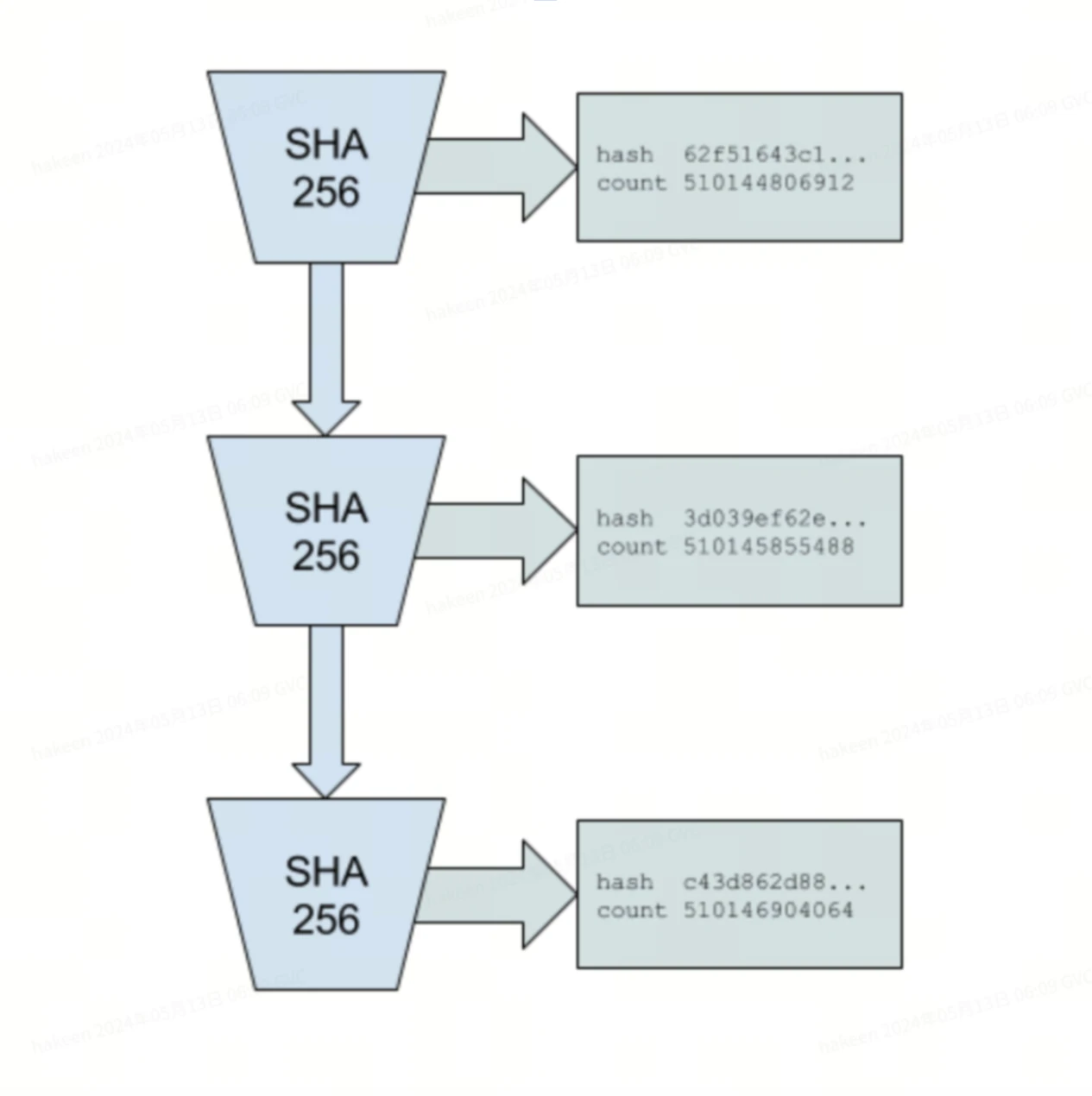
POH sequence diagram, image source: Solana Whitepaper
In Solana's POH sequence, the integrity of the entire sequence can be ensured by applying the sha256 algorithm, thus determining the integrity of the transactions within it. For example, if we package transactions into a block and generate the corresponding sha256 hash value, the transactions within this block are determined, and any change will result in a change to the hash value. This block's hash will then be used as part of the next sha256 function, and the hash of the next block will be added. This way, the previous and next blocks are both determined, and any change will result in a different new Y.
This is the core meaning of its Proof of History technology. The hash of the previous block will be used as part of the next sha256 function, similar to a chain, where the latest Y always contains proof of history.
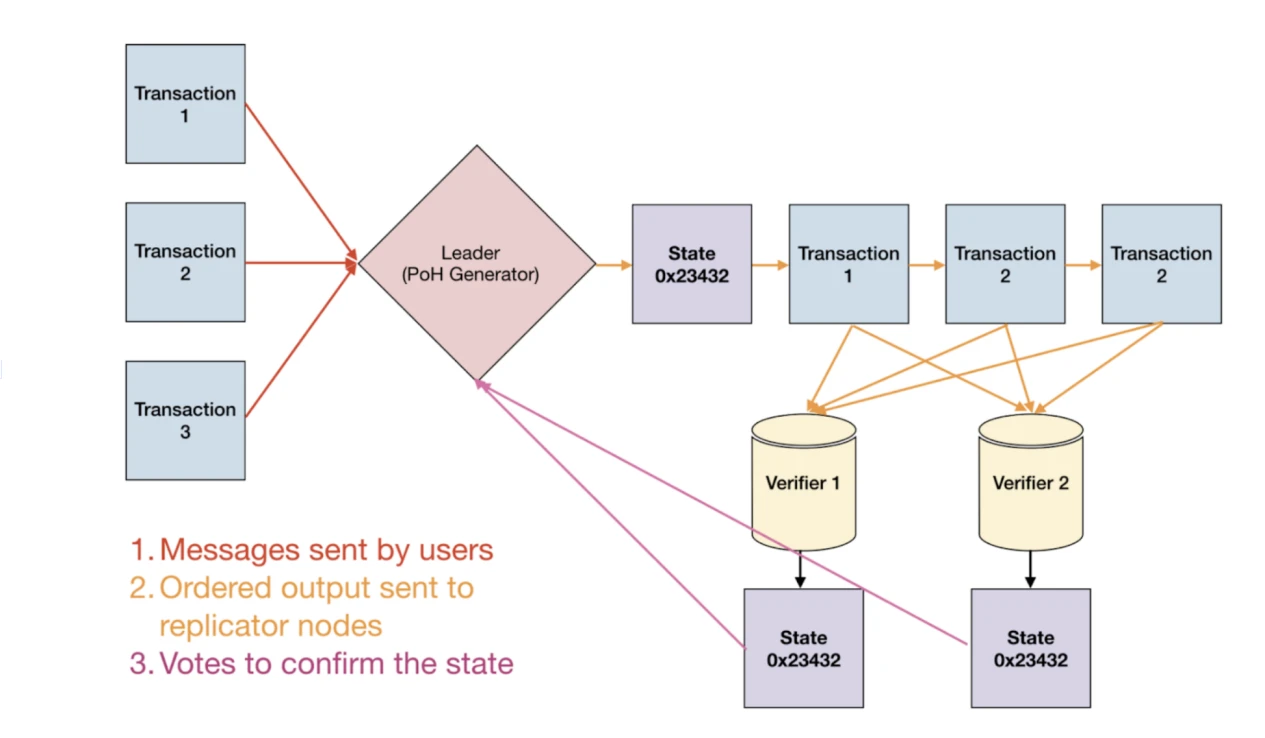
Transaction Flow architecture diagram, image source: Solana Whitepaper
In Solana's transaction flow architecture diagram, the transaction process under the POH mechanism is described. Through a rotation mechanism called Leader Rotation Schedule, a Leader node is generated among all on-chain validators. This Leader node collects and sorts transactions for execution, generates the POH sequence, and then propagates a block to other nodes.
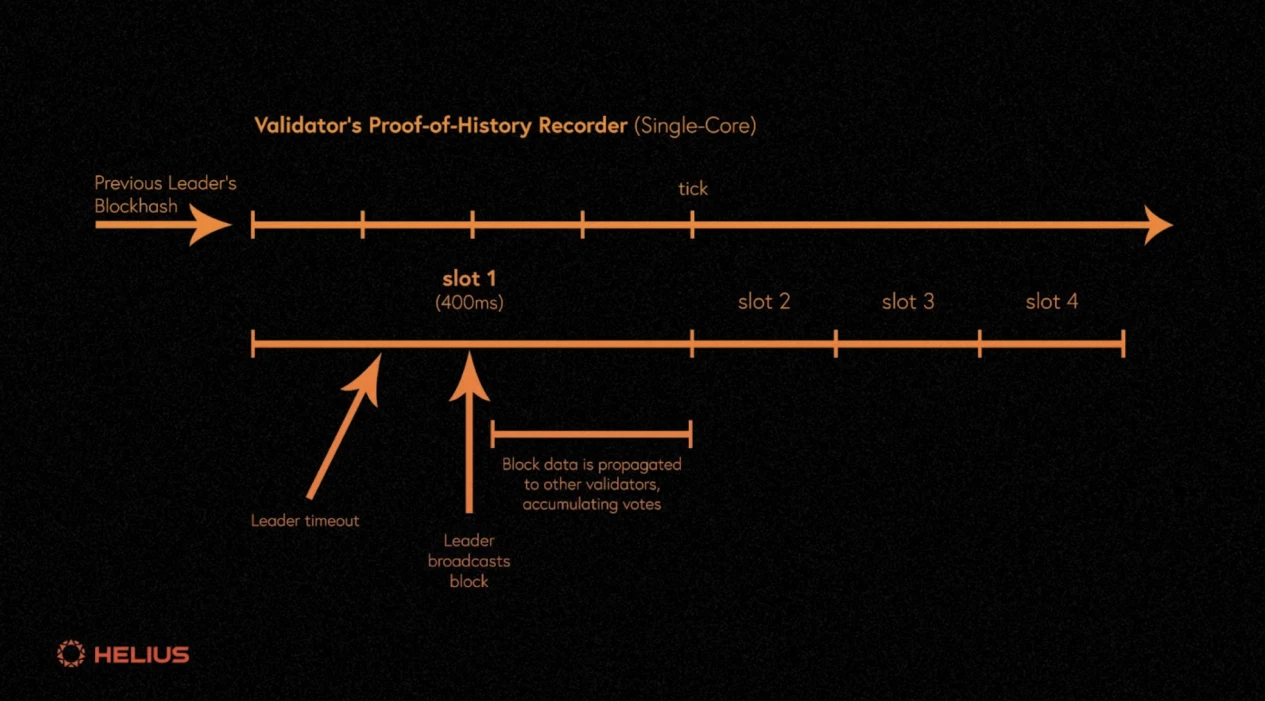
Leader election mechanism, image source: Helius
To avoid single point of failure at the Leader node, a time limit is introduced. In Solana, time is divided into epochs, with each epoch containing 432,000 slots. Each slot lasts 400ms, and within each slot, the rotation system assigns a Leader node. The Leader node must publish a block within the given slot time (400ms). Otherwise, the slot will be skipped, and the next Leader node for the next slot will be elected.
In general, the Leader node uses the POH mechanism to determine the historical transactions. Solana's basic time unit is the Slot, and the Leader node needs to broadcast a block within a slot. Users send transactions to the Leader through RPC nodes, and the Leader node packages and sorts the transactions, then executes to generate a block, which is then propagated to other validators. Validators need to achieve consensus on the transactions and order within the block through a mechanism, and this consensus is achieved using the Tower BFT consensus mechanism.
Tower BFT Consensus Mechanism
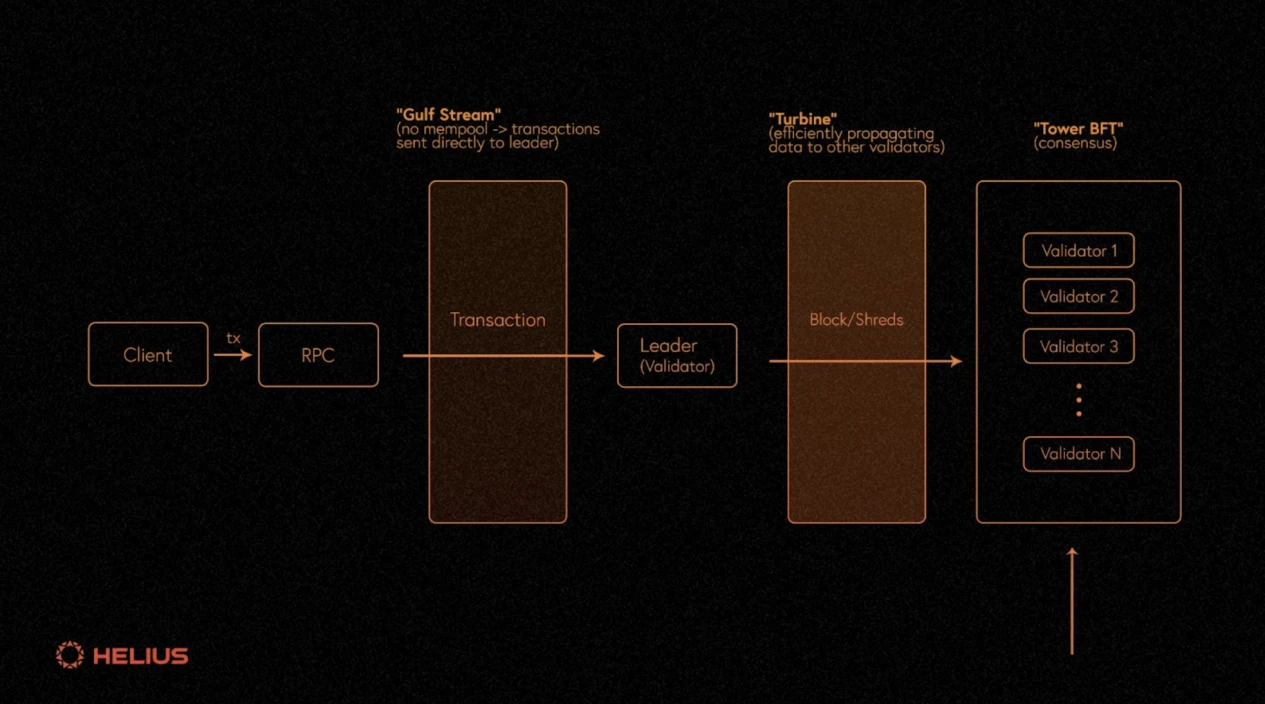
Tower BFT protocol, image source: Helius
The Tower BFT consensus protocol is derived from the BFT consensus algorithm and is a specific engineering implementation. This algorithm is still related to the POH algorithm. When validators vote on a block, if the validator's vote itself is a transaction, the block hash formed by user transactions and validator votes can also serve as historical proof, uniquely confirming the details of user transactions and validator vote details.
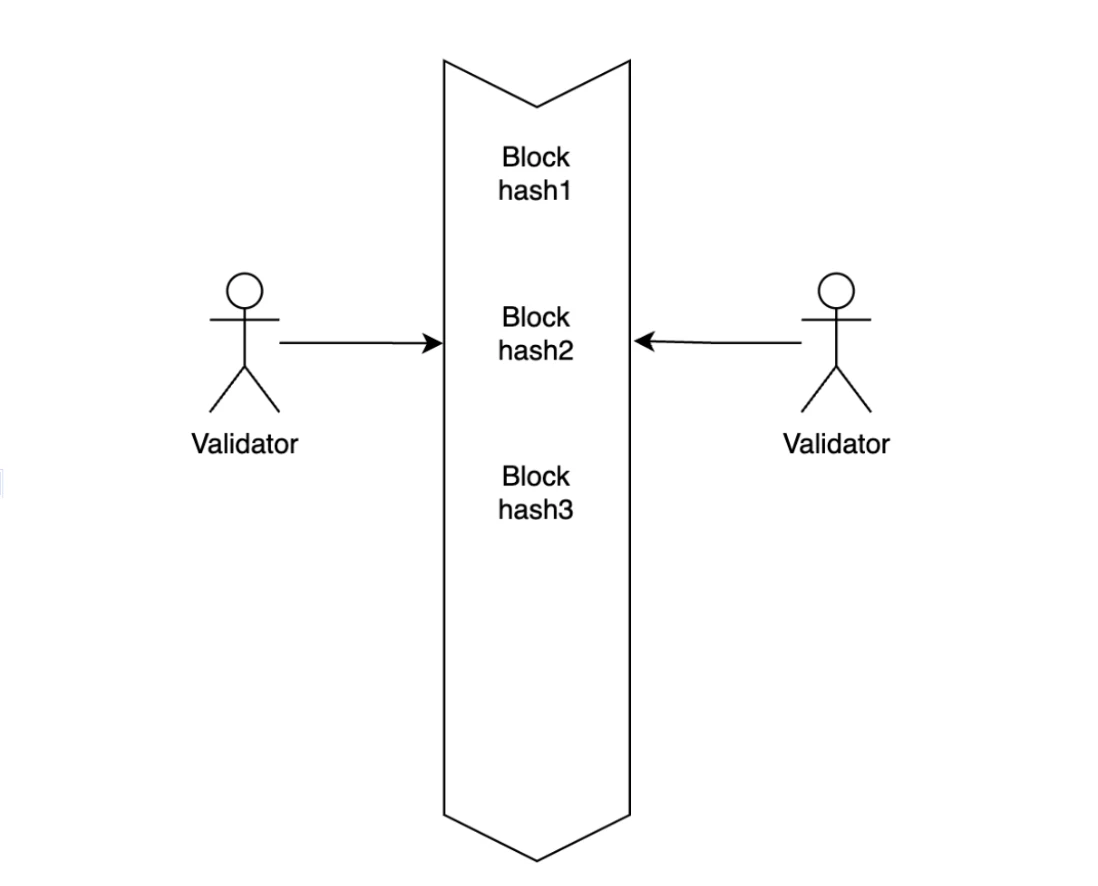
Voting diagram
In the Tower BFT algorithm, it is stipulated that if all validators vote on a block and more than 2/3 of the validators vote approve, the block is confirmed. The advantage of this mechanism is that it saves a lot of memory, as only the hash sequence needs to be voted on to confirm the block. In traditional consensus mechanisms, block flooding is generally used, where a validator receives a block and then sends it to surrounding validators, resulting in a lot of network redundancy because a validator receives the same block more than once.
In Solana, due to the large number of validators voting on transactions and the efficiency brought by the centralization of Leader nodes, as well as the 400ms slot time, this results in a particularly high overall block size and block production frequency. When large blocks are propagated, they also put a lot of pressure on the network. Solana uses the Turbine mechanism to solve the problem of propagating large blocks.
Turbine
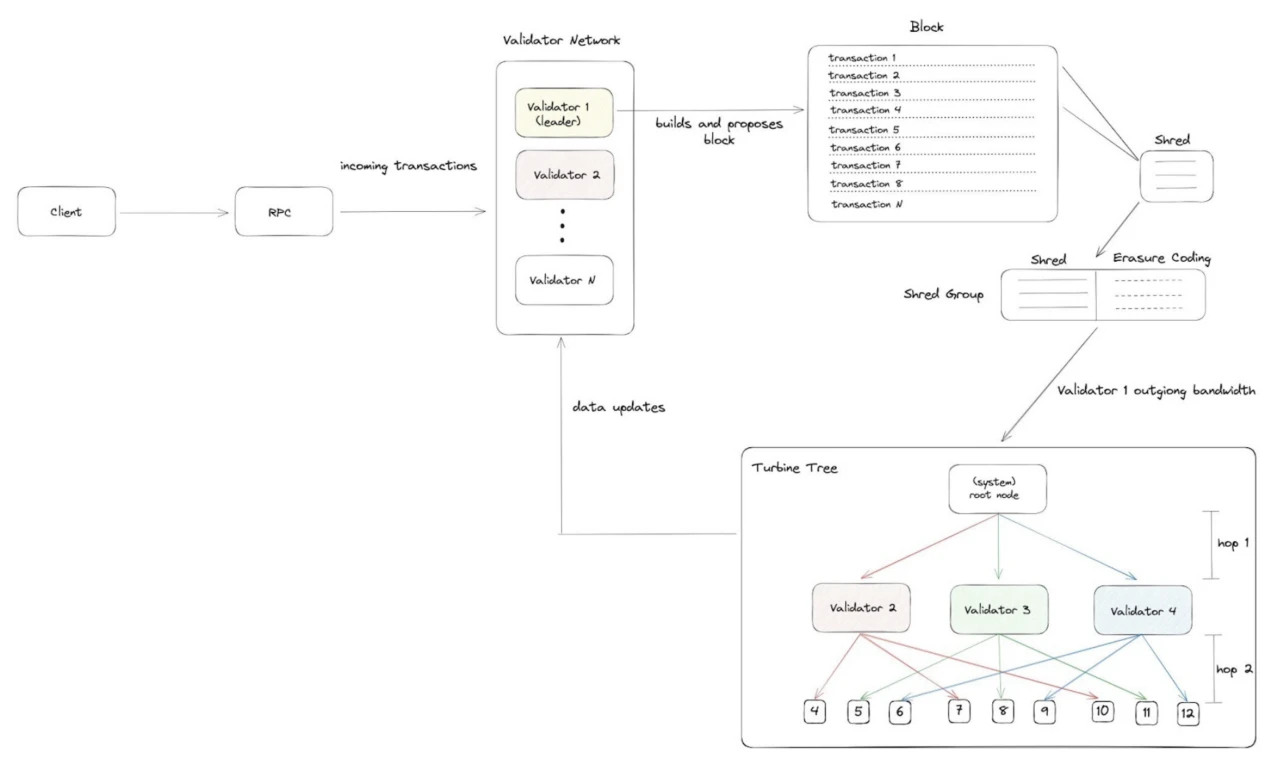
Turbine block propagation mechanism, image source: Helius
The Leader node splits the block into shreds through a process called Sharding, with the size specified in terms of the Maximum Transmission Unit (MTU). Then, it uses the Reed-Solomon erasure code scheme to ensure data integrity and availability.
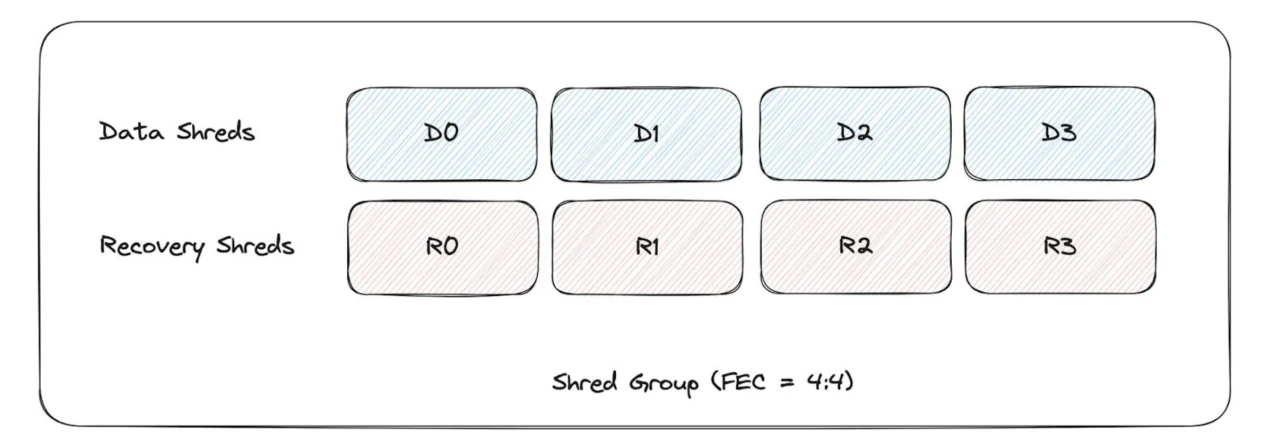
Reed-Solomon encoding scheme, image source: Helius
By dividing the block into four Data Shreds and using Reed-Solomon encoding to encode the four packets into eight packets to prevent packet loss and damage during data transmission, this scheme can tolerate up to a 50% packet loss rate. In actual testing, Solana's packet loss rate is approximately 15%, so this scheme is well compatible with the current Solana architecture.
In the underlying data transmission, UDP/TCP protocols are generally considered. Due to Solana's high tolerance for packet loss, the UDP protocol is used for transmission. The downside is that it does not retransmit in case of packet loss, but the upside is faster transmission. In contrast, the TCP protocol retransmits multiple times in case of packet loss, greatly reducing transmission speed and throughput. With Reed-Solomon, this scheme significantly increases Solana's throughput, with throughput increasing by 9 times in real-world scenarios.
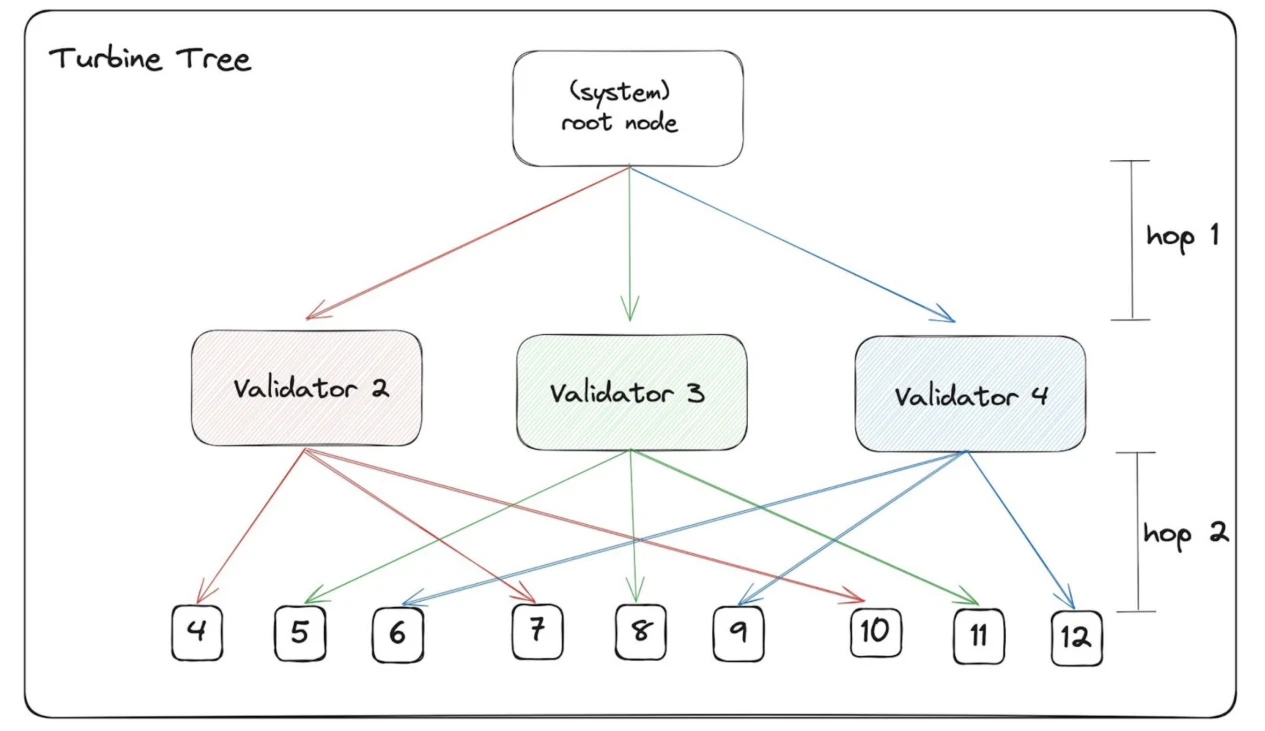
Layered propagation diagram, image source: Helius
After Turbine shards the data, it uses a multi-layer propagation mechanism for transmission. The Leader node hands the block to any block validator before the end of each slot, and the validator shards the block and generates erasure code, then initiates Turbine propagation. First, it propagates to the root node, which then determines which validators are in which layer. The process is as follows:
Create a node list: The root node consolidates all active validators into a list, then sorts them based on each validator's stake in the network (i.e., the amount of SOL staked), with higher-weight validators in the first layer, and so on.
Node grouping: Each validator in the first layer also creates its own node list to build its first layer.
Layer formation: Nodes are divided into layers from the top of the list, and by determining the depth and breadth, the approximate shape of the entire tree can be determined. This parameter affects the propagation rate of shreds.
Nodes with a higher stake are placed in higher layers during layer division, allowing them to obtain complete shreds earlier, enabling them to reconstruct the complete block. For validators in subsequent layers, the probability of obtaining complete shreds is lower due to transmission losses. If these shreds are insufficient to construct a complete shard, the Leader is required to retransmit directly. At this point, data transmission occurs within the tree, while validators in the first layer have already constructed the complete block, so the time for validators in the subsequent layers to complete block construction and vote is longer.
This mechanism is similar to the single-node mechanism of the Leader node. There are also priority nodes in the block propagation process, which first obtain shreds to construct a complete block and achieve consensus through voting. Pushing redundancy to deeper layers significantly accelerates finality and maximizes throughput and efficiency. In practice, the first few layers may represent 2/3 of the nodes, making the votes of subsequent nodes irrelevant.
SVM
Solana is able to process thousands of transactions per second, mainly due to its POH mechanism, Tower BFT consensus, and Turbine data propagation mechanisms. However, the SVM, as a virtual machine for state transitions, can reduce the overall system throughput if the Leader node's transaction execution speed is slow. Therefore, Solana has proposed the Sealevel parallel execution engine to speed up transaction execution.
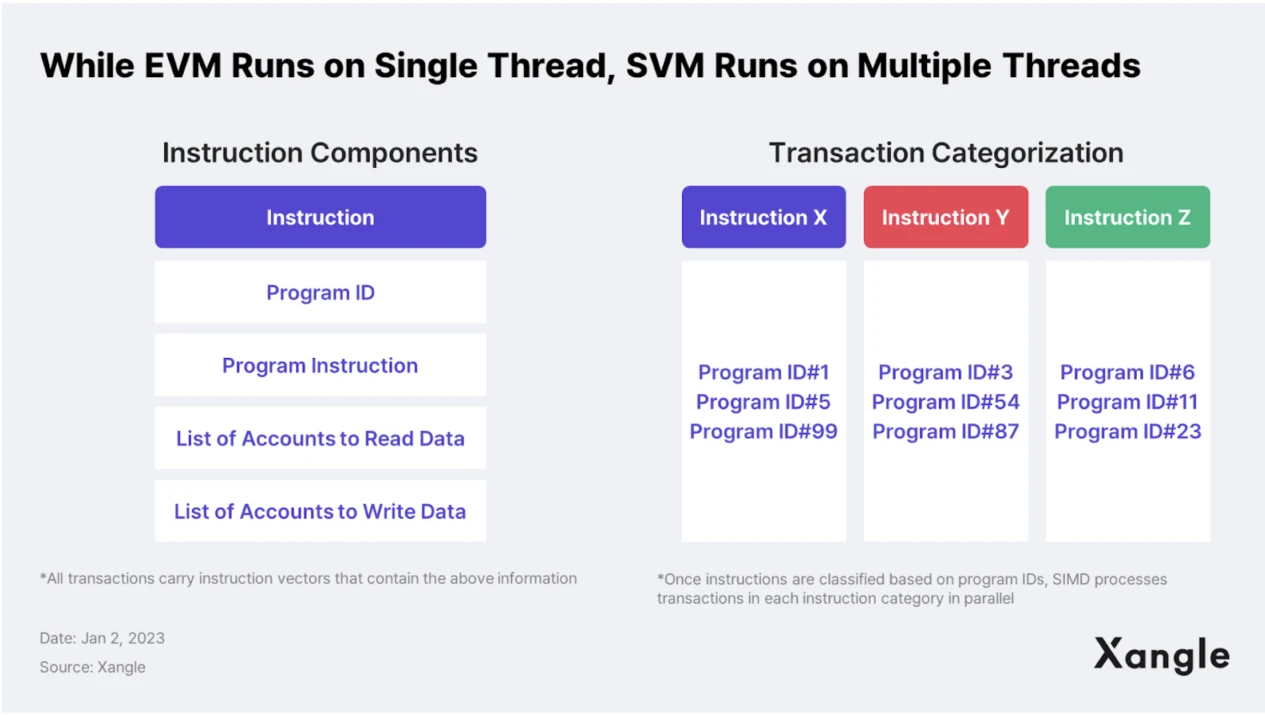
Sealevel Parallel Execution Diagram, Image Source: Xangle
In the SVM, instructions consist of four parts, including program ID, program instructions, and a list of accounts for reading/writing data. By determining whether the current account is in a read or write state and whether there are conflicts in the operations for state changes, the transaction instructions for accounts with no conflicts in state can be parallelized, with each instruction represented by a Program ID. This is one of the reasons why Solana's validators have high requirements, as they need validators' GPU/CPU to support Single Instruction, Multiple Data (SIMD) and Advanced Vector Extensions (AVX) capabilities.
Ecosystem Development
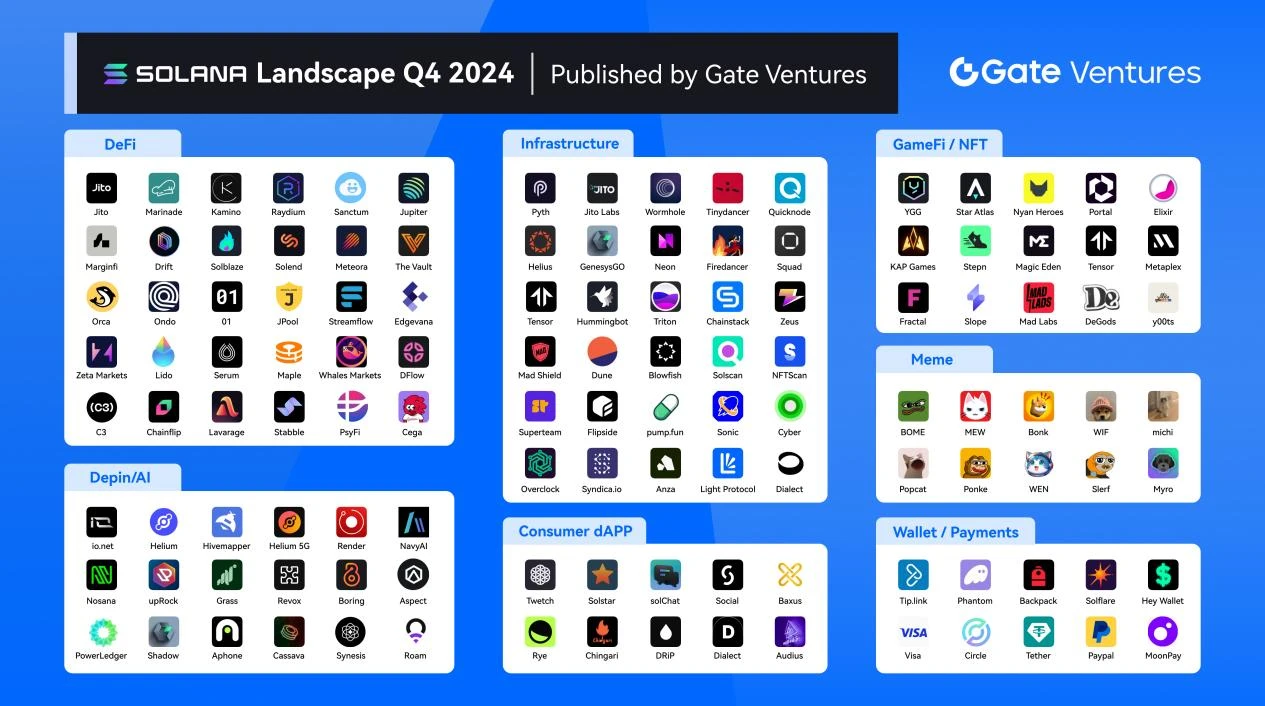
Solana Ecosystem Landscape, Image Source: Gate Ventures
In the current development of the Solana ecosystem, it is increasingly leaning towards practical utility, such as Blinks, Actions, and even Solana Mobile. The official supported application development direction also leans more towards consumer applications rather than infinite internal competition for infrastructure. With Solana's current sufficient performance, the variety of applications is more diverse. In contrast, Ethereum's ecosystem still focuses mainly on infrastructure and scaling technologies due to its low TPS. When the infrastructure cannot support applications, it cannot build consumer applications, leading to an imbalance of excessive investment in infrastructure and insufficient investment in applications.
DeFi
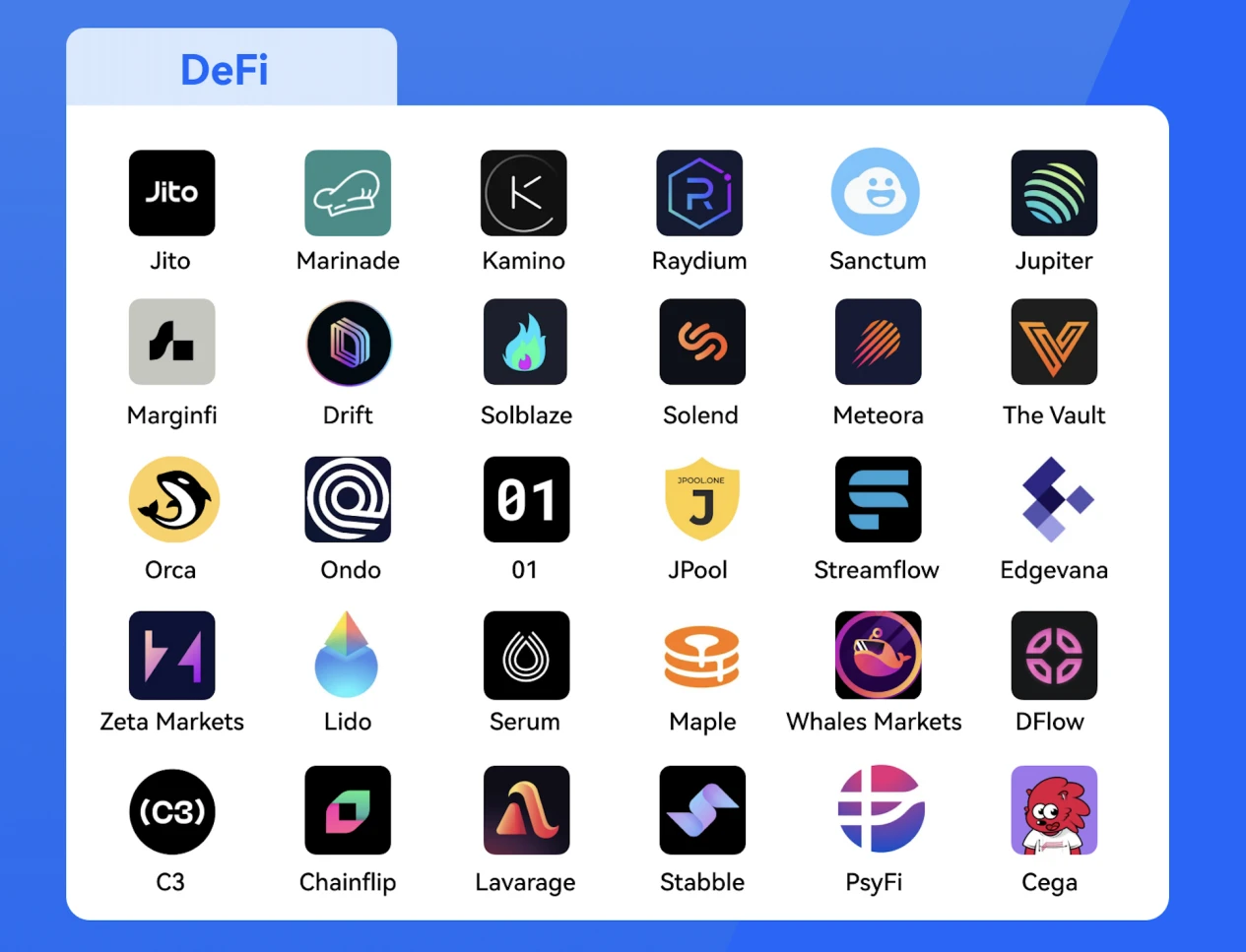
DeFi Landscape, Image Source: Gate Ventures
In the DeFi protocols on Solana, there are many projects that have not yet been launched, including Kamino (first Lending), Marginfi (Lending + Restaking), SoLayer (Restaking), Meteora, etc. Due to Solana's united ecosystem atmosphere, typically, when one project is scheduled to launch, other projects will try to avoid the same period to attract enough market attention.
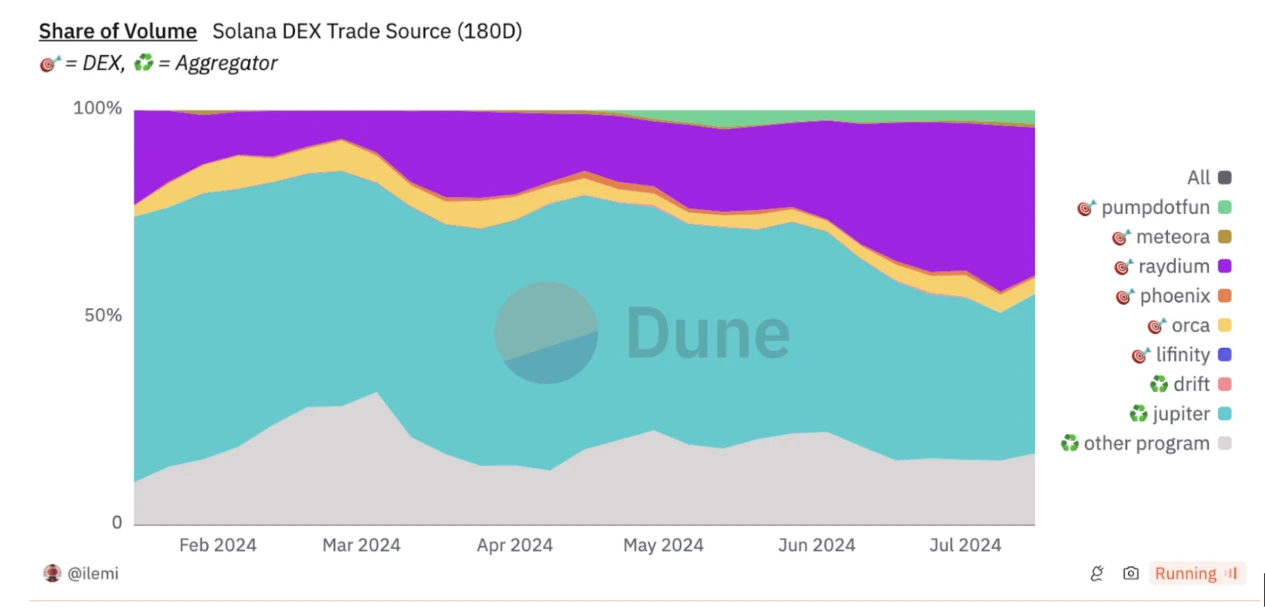
DEX Market Share, Image Source: Dune
The competition in the entire DEX sector is fierce, and the leader has also undergone multiple migrations, from Raydium and Orca to the current dominance of Jupiter.
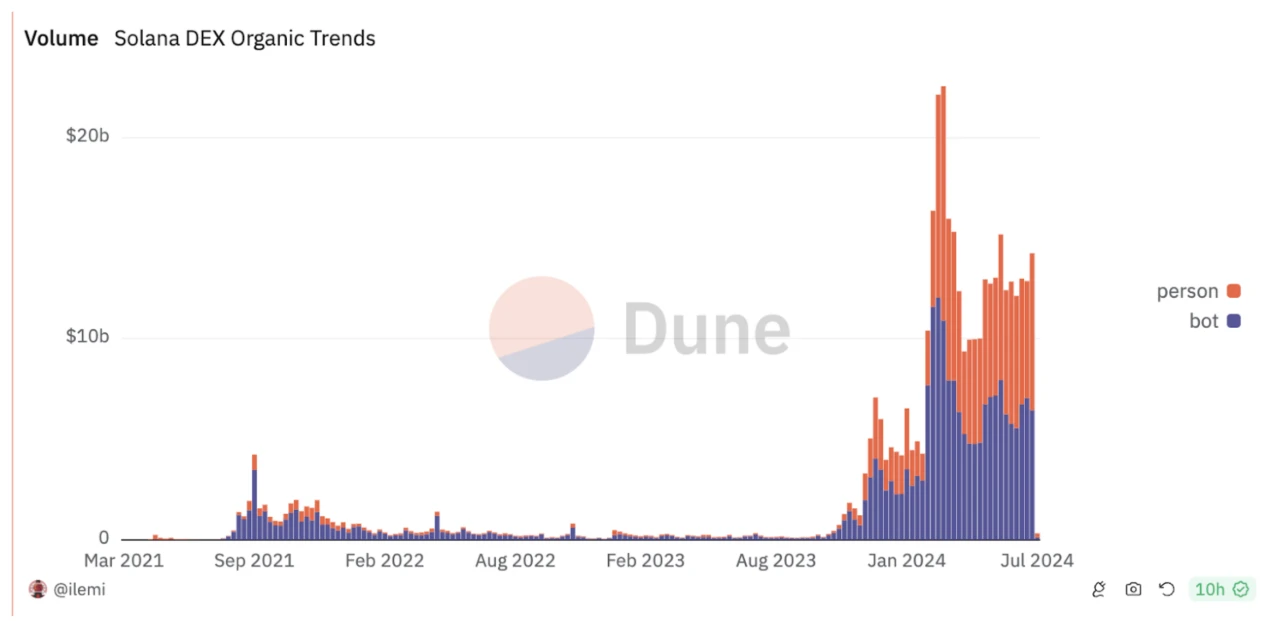
Initiators of DEX trades, Image Source: Dune
It is worth noting that approximately 50% of DEX trades are initiated by MEV bots, mainly due to their low fees and active meme trading, which has fostered profitable MEV. This is also one of the main reasons for frequent transaction failures and crashes during peak user trading.
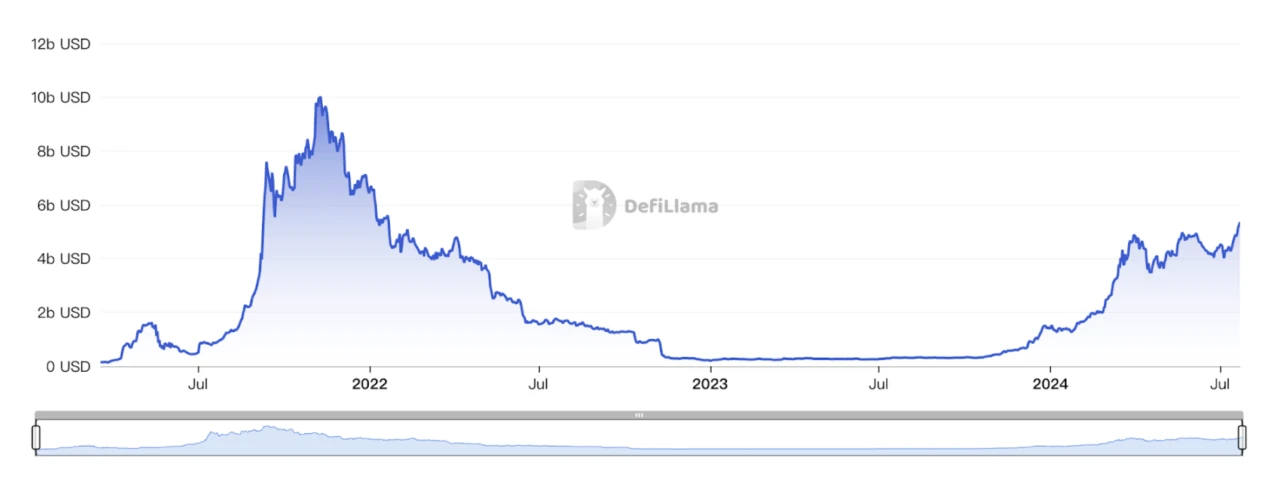
Solana TVL, Image Source: Defillama
With the rise in the price of SOL, the USD nominal TVL of DeFi protocols on Solana has also experienced explosive growth. The upward trend in TVL has not stopped, and a new wave of upward trends is forming.
In summary, although the competition in the Solana race is fierce, there are still changes. Unlike Uniswap on Ethereum, which occupies users' brand awareness, even DEX, which should have strong stickiness and network effects, faces the risk of being replaced. The MEV bot-filled transactions on the Solana main chain still pose significant user experience issues that need to be addressed. Overall, Solana's TVL is still growing very rapidly, and the subsequent development of the DeFi ecosystem is still very promising. The brand awareness of these applications does not strongly occupy users, which is a potential motivation for entrepreneurs to choose the chain.
Infrastructure
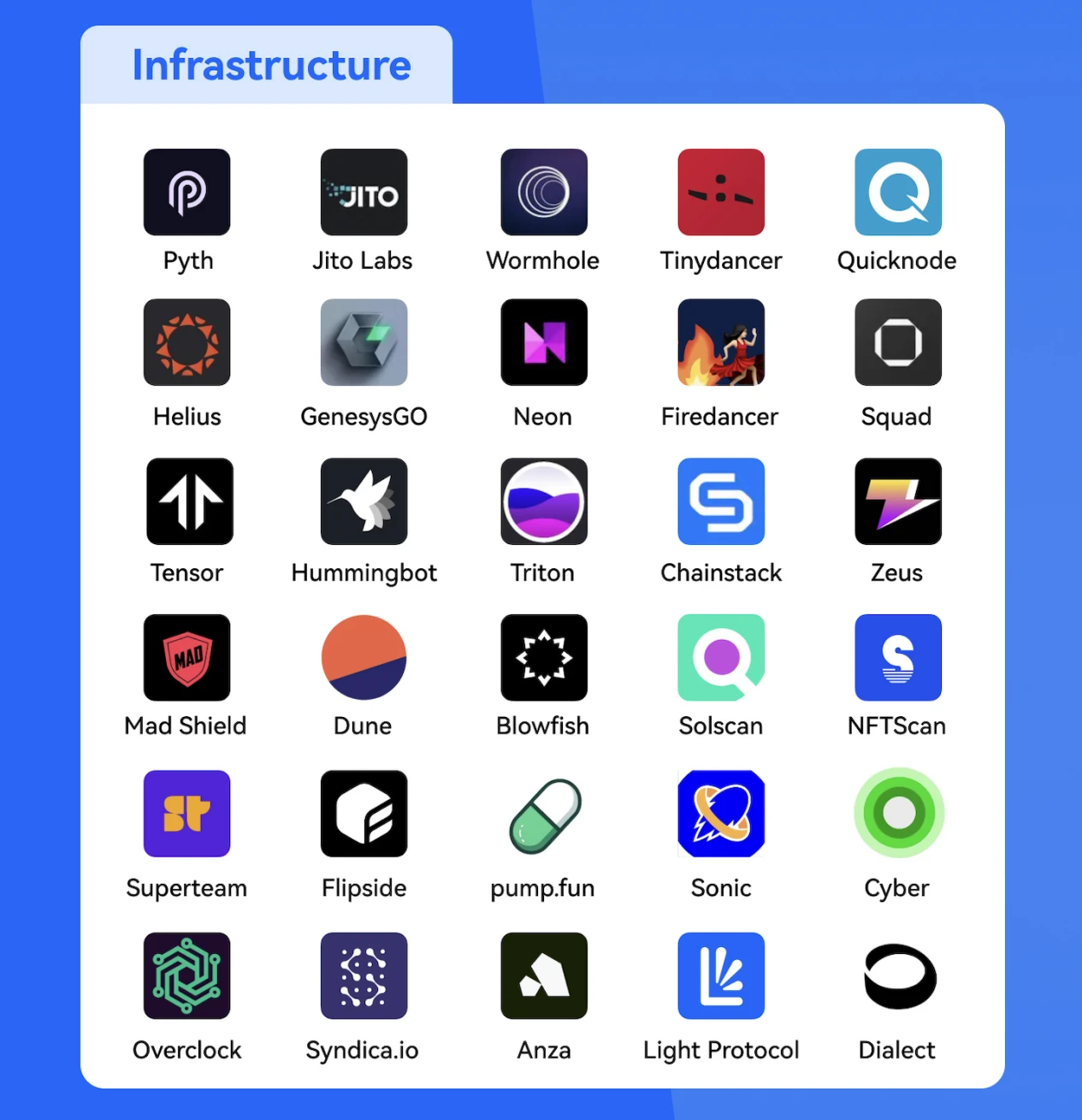
Infrastructure Landscape, Image Source: Gate Ventures
In infrastructure development, the main leaders are the oracle Pyth and the cross-chain bridge Wormhole, as well as some targeted solutions that the public may be less familiar with, such as:
Jito Labs: Focuses on building MEV solutions on Solana, and its Jito Labs client has built Bundle and pseudo mempool to allow researchers to conduct MEV. Currently, its market share exceeds 50%. In addition, its LSD protocol Jito's staked SOL is close to 12 million and is still growing rapidly.
Helius: As an active contributing community on Solana, Helius has the most comprehensive research on Solana and contributes code through research.
GenesysGo: Its product ShdwDrive is a data storage project in Solana, dedicated to supporting projects that can be commercialized, including social data and website hosting. It is still in the testing phase. In addition, its parent company GenesysGo is also building various public goods and conducting research for the Solana community.
In addition, there are still many projects on Solana waiting to be explored by the Chinese community. We have indeed found that these infrastructures have a huge impact on Solana's protocol-level construction, ecosystem development, and community, and there may be opportunities for further exploration of their potential, whether in investment or cooperation.
Gaming / NFT
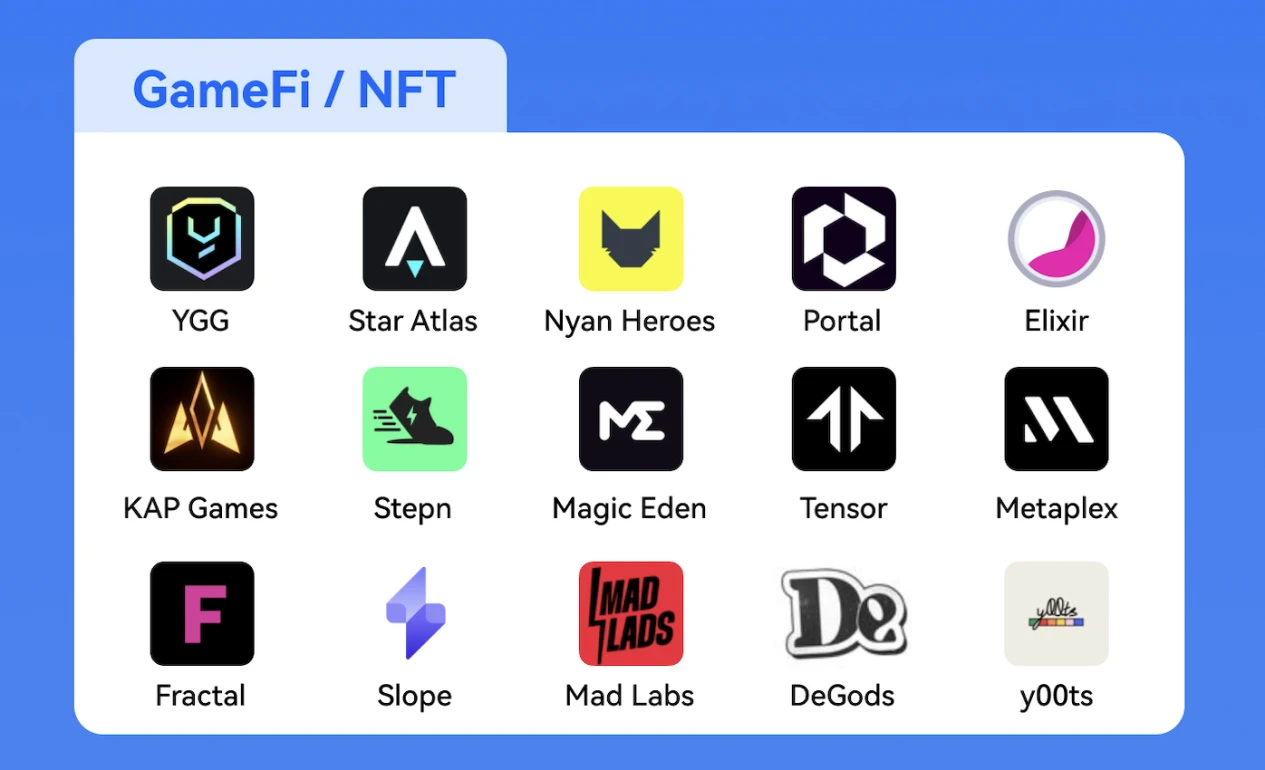
Gaming / NFT Landscape, Image Source: Gate Ventures
On Solana, there is also a rich GameFi and NFT ecosystem, with Mad Labs occupying a relatively important position in the entire Solana ecosystem. Many projects prioritize airdrops to Mad Labs holders, a position previously held by DeGods. The NFT market has also undergone changes, with Magic Eden, previously the most widely used, now transitioning to Tensor.
DePin / AI
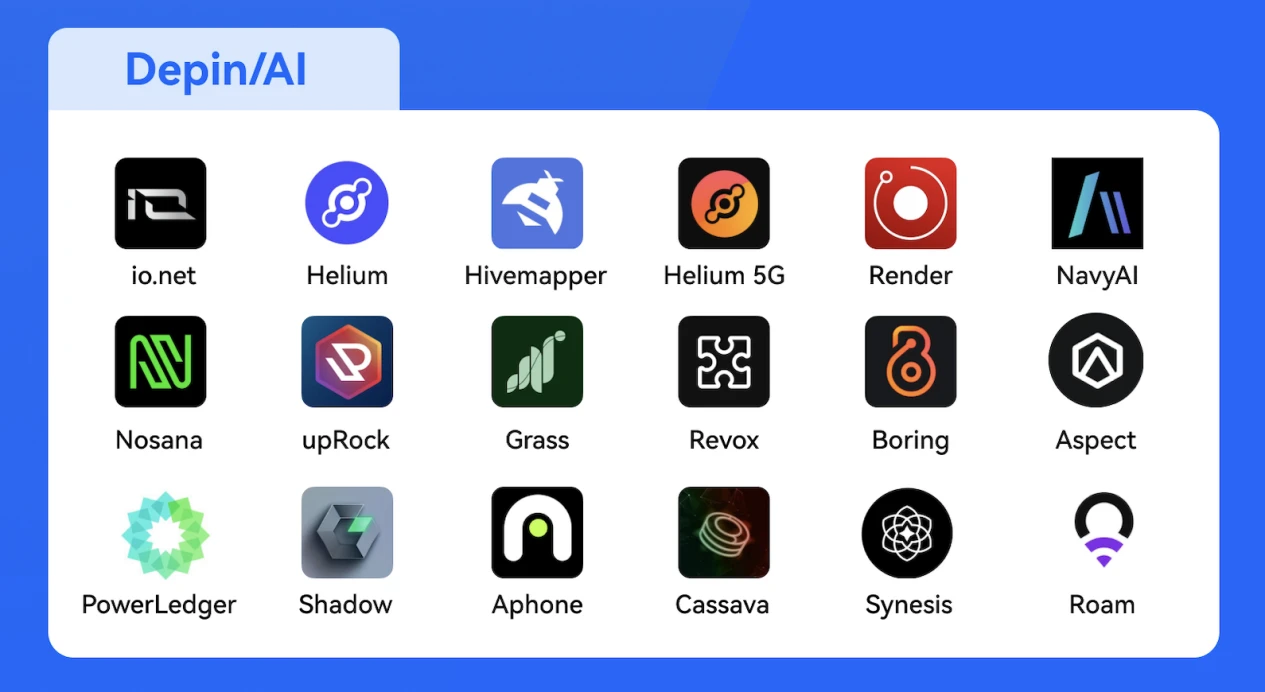
DePin Landscape, Image Source: Gate Ventures
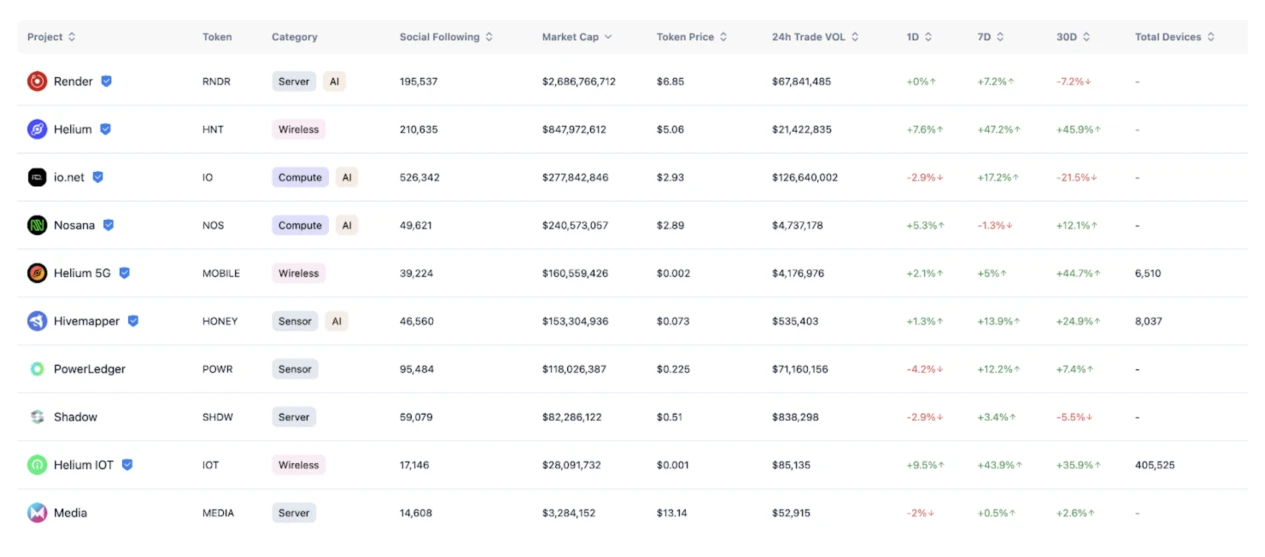
DePin Data Overview, Image Source: DePin Scan
Currently, in the Solana DePin market, Render is undoubtedly the leader with actual business operations. With Solana's development strategy centered around practical applications, it has also seized the narrative of DePin in this round of recovery. In the first half of the year, a large number of new DePin projects were built on Solana, including io.net, Nosana, Shadow, and others.
Consumer
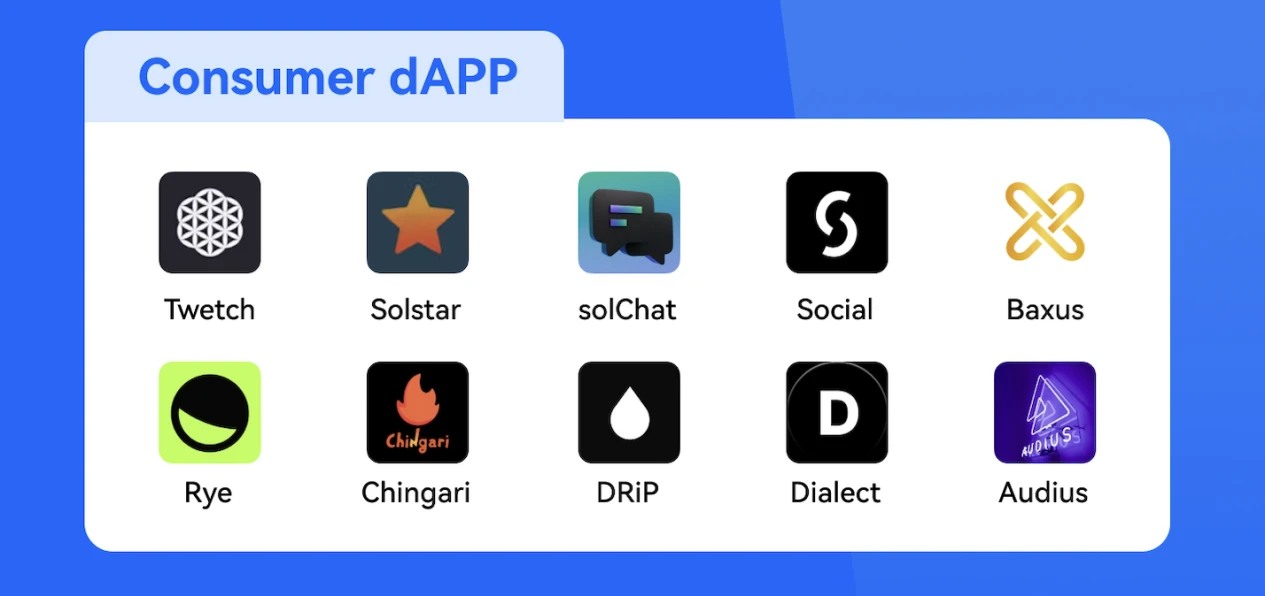
Consumer Landscape, Image Source: Gate Ventures
Whether it's Solana Mobile or the Solana Ecosystem's official website specifically building columns for consumer applications, the invention of Actions and Blinks demonstrates Solana's vision for the commercialization and practicality of blockchain. The release of its Mobile app is also about bringing web-based dapps to mobile, which aligns with human nature and internet development trends. Therefore, applications are likely to flourish in this environment, with Stepn being the most typical example.
Looking at the current running consumer applications, most of them have not yet found a breakthrough, so they still cannot truly land in the commercial world. This includes factors such as single product innovation, single business models, weak marketing in Web2, the demand for Gas Fees, and the entry barriers for tokens.
However, consumer applications are the ultimate landing scenario for blockchain technology and determine the ceiling for public chains. Therefore, Solana's exploration of consumer applications on mobile is very necessary, and our long-term exploration in this direction is also necessary. Especially in the current Ethereum ecosystem, where infrastructure far exceeds applications. Ultimately, infrastructure serves applications.
Payments
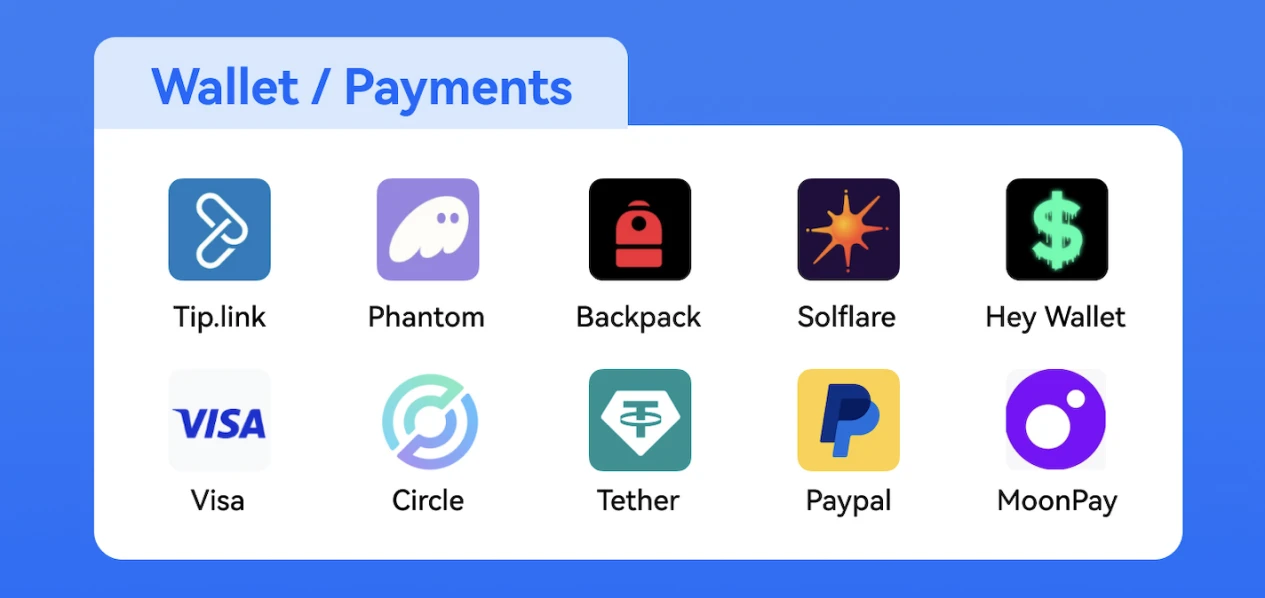
Payment Landscape, Image Source: Gate Ventures
Wallets on Solana include Phantom, Backpack, TipLink, and others. Similar to DEX, there is not a strong brand effect here, so entrepreneurs have more opportunities. Previously, the leading wallet was Phantom, but it has now transitioned to Backpack, which is built by Mad Labs. It is worth mentioning that Mad Labs is also the NFT leader on Solana.
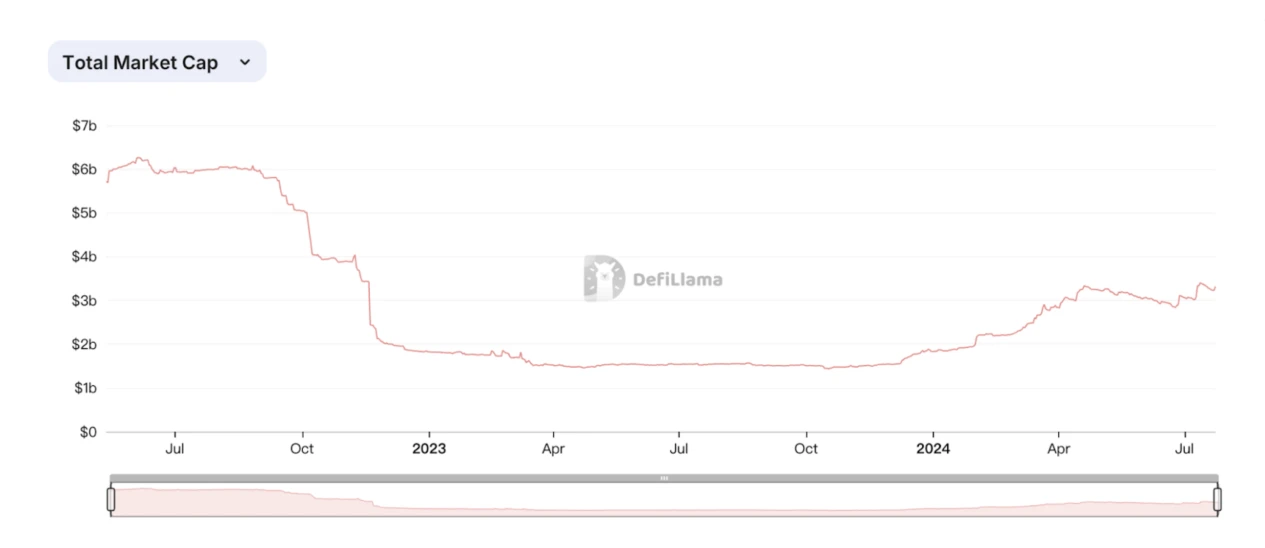
Stablecoin Issuance on Solana, Image Source: Defillama
It is currently collaborating with PayPal, Visa, and others for on-chain stablecoin payments and transfers. This business scenario itself is very conducive to the fast finality and low Gas Fees of the Solana chain. Currently, its on-chain stablecoin is in a slow growth state.
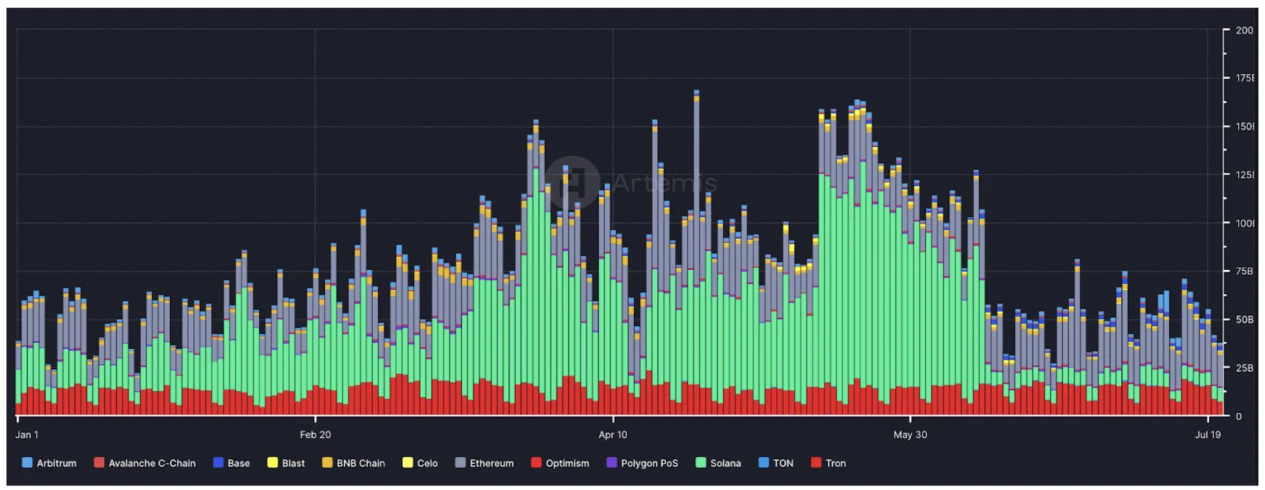
Stablecoin Transfer Stack Chart YTD, Image Source: Artemis
Solana had a remarkable market share of stablecoin transfers in the first half of the year. However, after June, its market share has significantly declined. Solana's performance was outstanding in the first half of the year, but its transfer data has shown a clear downward trend at the beginning of the second half of the year.
Competitor Data
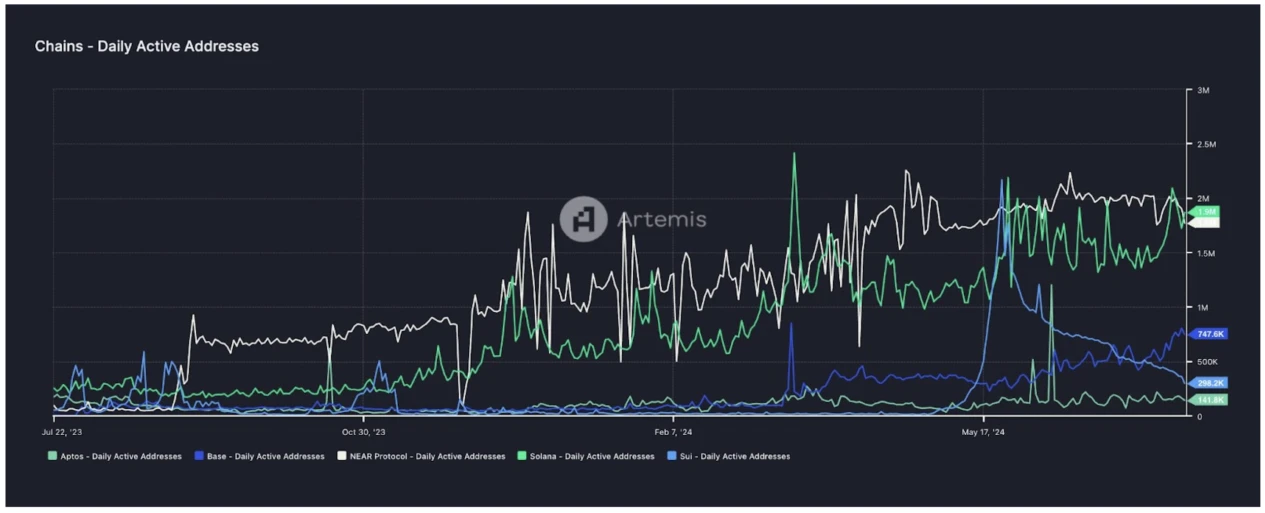
Active Addresses on Chain, Image Source: Artemis
Among the various public chains, Base is seen as a potential competitor to Solana's EVM ecosystem. The number of active addresses on Base is rapidly increasing, while Solana, despite having a first-mover advantage, is still in a high-growth phase. NEAR maintains a high position, but Aptos and Sui are lagging behind in the competition among public chains.
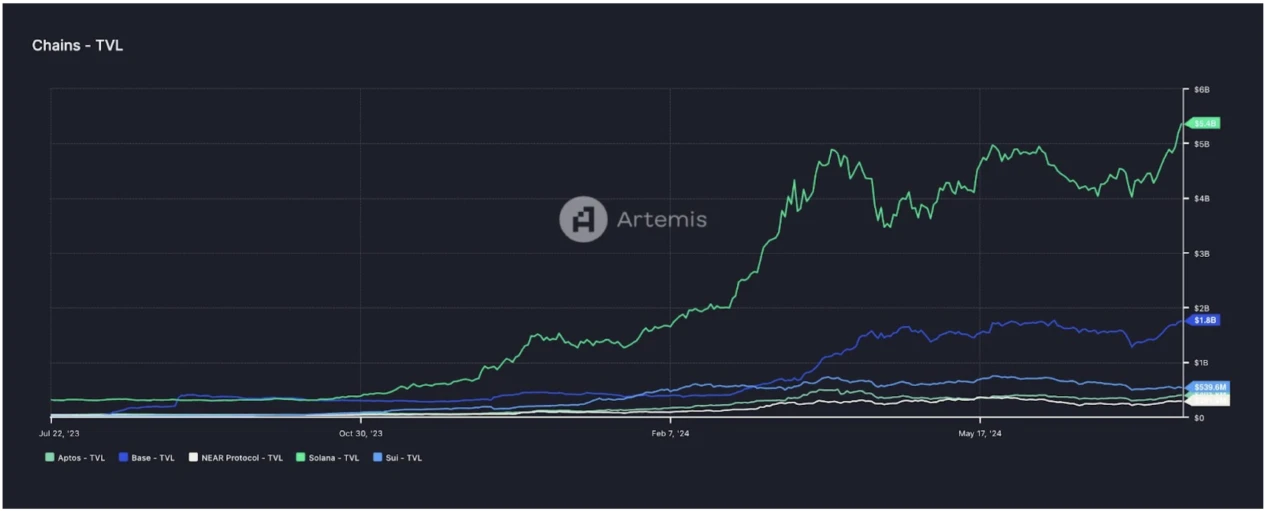
TVL Comparison, Image Source: Artemis
Solana has made significant progress in TVL in the DeFi field, reaching a historic high, and has a considerable distance compared to other public chains. However, it is worth noting that Base is also in a high-growth phase.
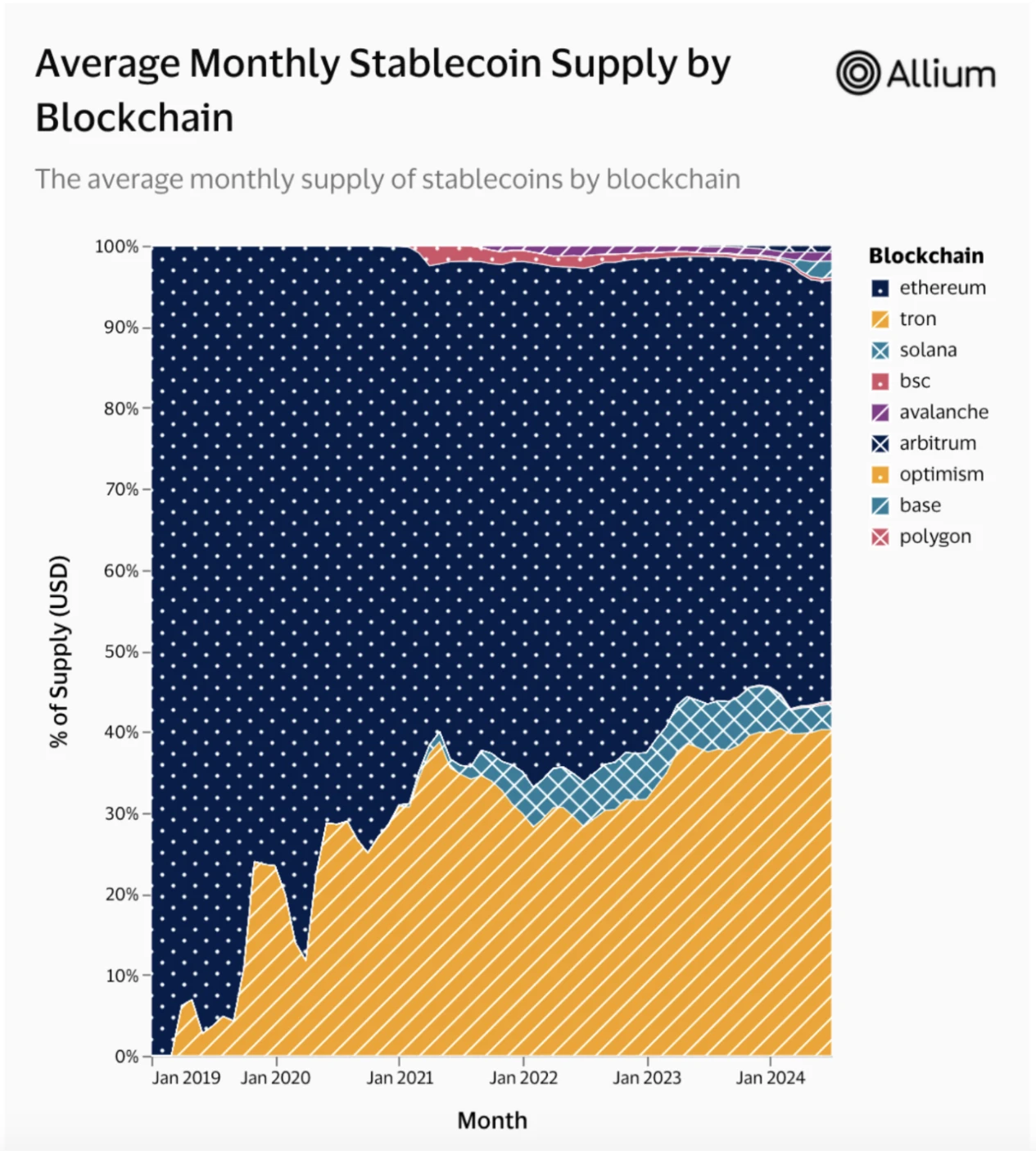
Reserves of Stablecoins on Public Chains, Image Source: Allium
Currently, Solana's market share of stablecoin supply has been sluggish, and with the emergence of multiple chains, Ethereum's market share has naturally decreased, while Base's market share is quietly increasing.
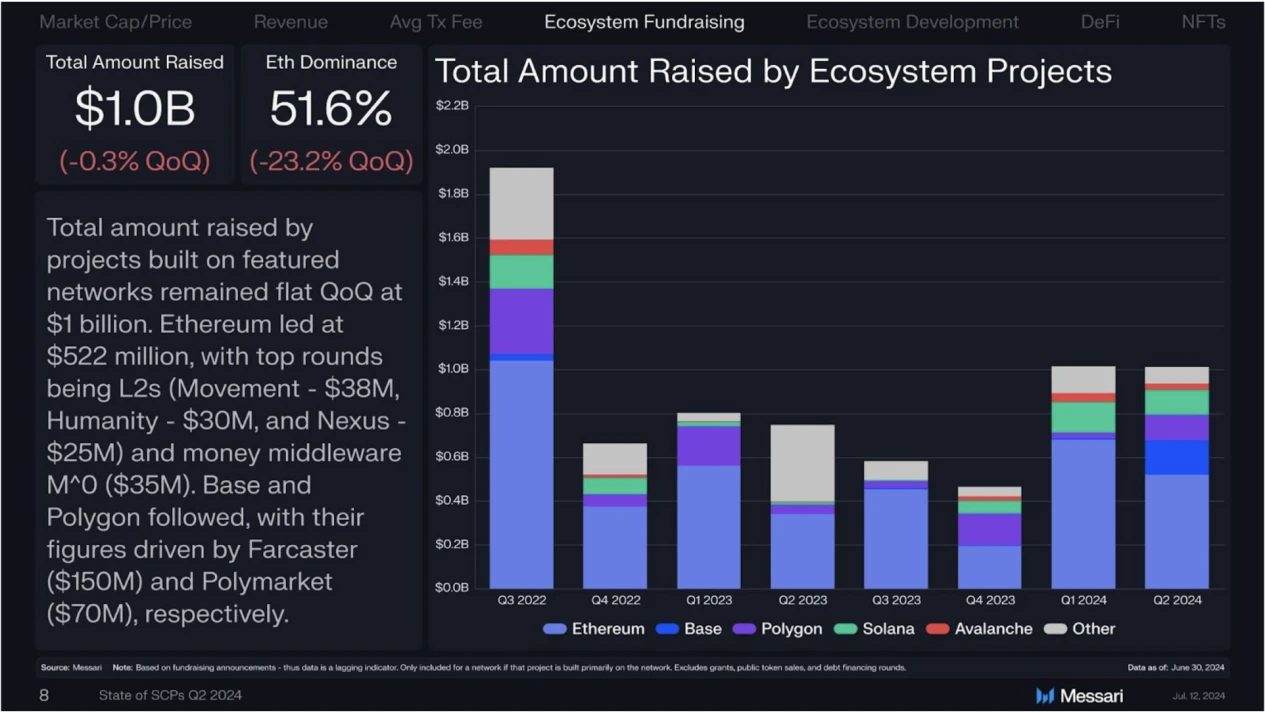
Financing Data, Image Source: Messari
In terms of financing in the capital market, the financing frequency of the Base ecosystem has significantly increased in the last quarter, surpassing the Solana ecosystem. Therefore, it can be seen through the market share of various on-chain data and capital financing that the competition between Base and Solana in the market is valid. With the maturity of Base, this competitive pressure will increase for Solana. Both Base and Solana have similar visions, aiming to achieve the vision of Mass Adoption of Cryptio Native Consumer Apps with high TPS.
Technical Challenges
Downtime
Solana has experienced multiple downtimes in its history, and we have outlined the specific events and reasons for the downtime:
- May 4, 2021
Network performance degradation leading to a large number of transactions not being processed
- September 3, 2021
Unstable network and performance degradation lasting approximately 1 hour
- September 14, 2021
Grape Protocol's IDO event on the Raydium platform saw a surge in activity, with many users sending a large number of transactions through scripted bots, causing "memory overflow" that led to validator node crashes, resulting in the entire network being unable to produce blocks for a prolonged period of 17 hours.
- January 21, 2022
Significant market volatility led to a high volume of arbitrage bot transactions, causing severe network congestion and a downtime of 30 hours.
- May 1, 2022
A new NFT project minting resulted in a large number of bot transactions, causing the mainnet nodes to lose consensus, leading to a block production halt for 7 hours.
- June 1, 2022
A durable nonce function vulnerability in transactions led to a network restart, resulting in a downtime of approximately 4.5 hours.
- October 1, 2022
Network downtime due to node configuration errors
- February 25, 2023
Issues with Solana's mainnet performance forced validator nodes into "vote-only" safety mode, unable to process user transactions.
- February 6, 2024
Failure of the BPF (Berkley Packet Filter) loader, resulting in a downtime of 4 hours and 46 minutes
Solana's network architecture, such as the Gulfstream Leader election mechanism and the single-node risk of Leader nodes, has made subsequent prediction of Leader nodes feasible. When network transactions increase, it puts significant memory pressure on single nodes, and Leader nodes need to be ready to retransmit blocks to nodes in the Turbine tree at any time, or else they cannot complete consensus voting. When a large number of DDoS attacks occur, single node failures leading to system downtime become extremely frequent.
In summary, downtime is mainly a problem of being unable to produce blocks, possibly due to single node failures caused by the Leader mechanism, issues in block assembly, or the consensus layer's inability to reach consensus on blocks, leading to the inability to produce blocks. Overall, this is closely related to Solana's architecture and the testing process of its software.
Transaction Failures

Percentage of Failed User Transactions, Image Source: Dune
Users who have used Solana are likely aware that many of our transactions often fail to submit successfully, and after some time, they are found to have failed, resulting in a poor user experience. According to statistics, around 35% of user-submitted transactions fail, requiring users to submit multiple times, and this proportion will be even higher during periods of significant on-chain volatility.
The main reason for this is the network layer technology QUIC, which is a relatively new technology.
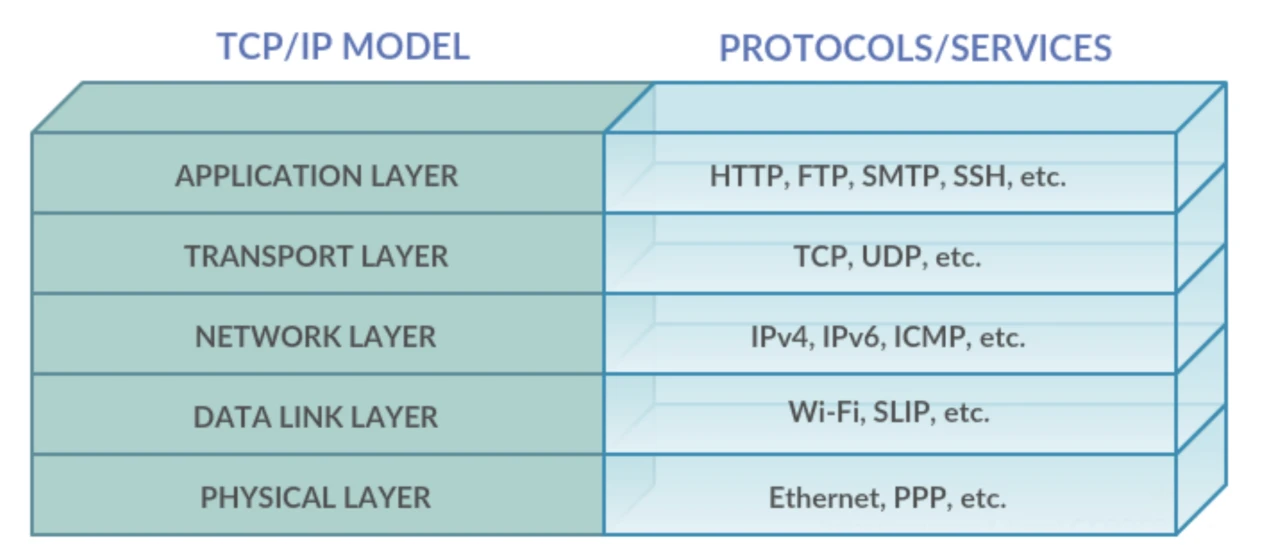
Network Protocol Layer - 5-Layer Structure, Image Source: Research Gate
QUIC (Quick UDP Internet Connections) is a transport layer improvement proposed by Google for the HTTP 2.0 protocol. This experimental protocol is developed based on the UDP transport layer protocol and is also known as HTTP 3.0.
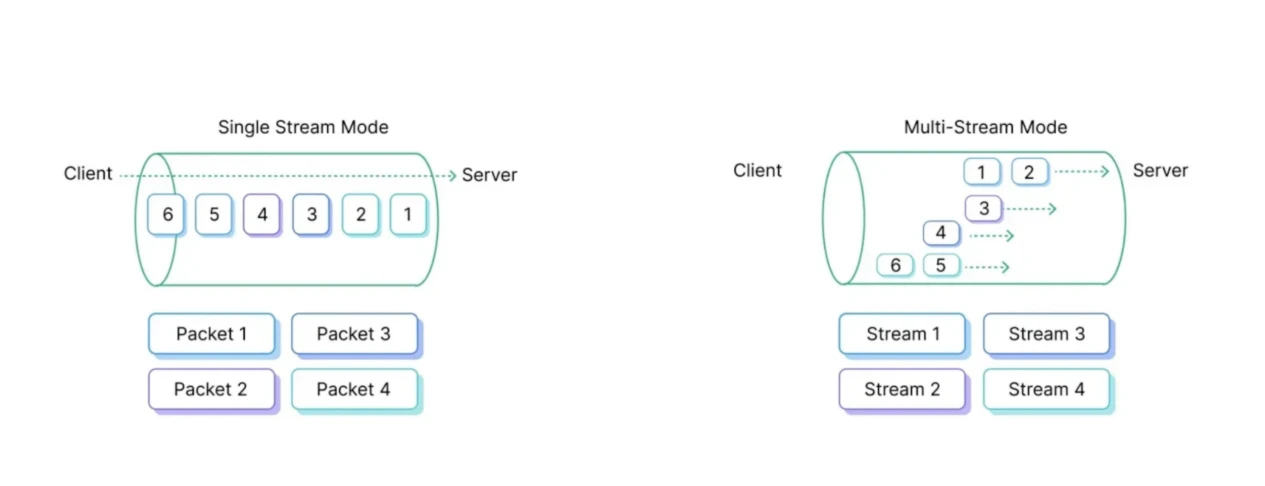
HTTP/2 vs. QUIC Diagram, Image Source: EMQX
TCP has higher reliability than UDP, but UDP has a higher rate than TCP because TCP has congestion control mechanisms and retransmits lost packets when packets are lost. UDP has a higher rate but lower reliability. Google aims to build a transport layer protocol, QUIC, that is both reliable and fast. The most core feature of QUIC is independent logical streams. It allows multiple data streams to be transmitted in parallel on a single connection, and each stream can be handled independently. In contrast, TCP only supports a single data stream and requires receiving and acknowledging each packet in the order they were sent.
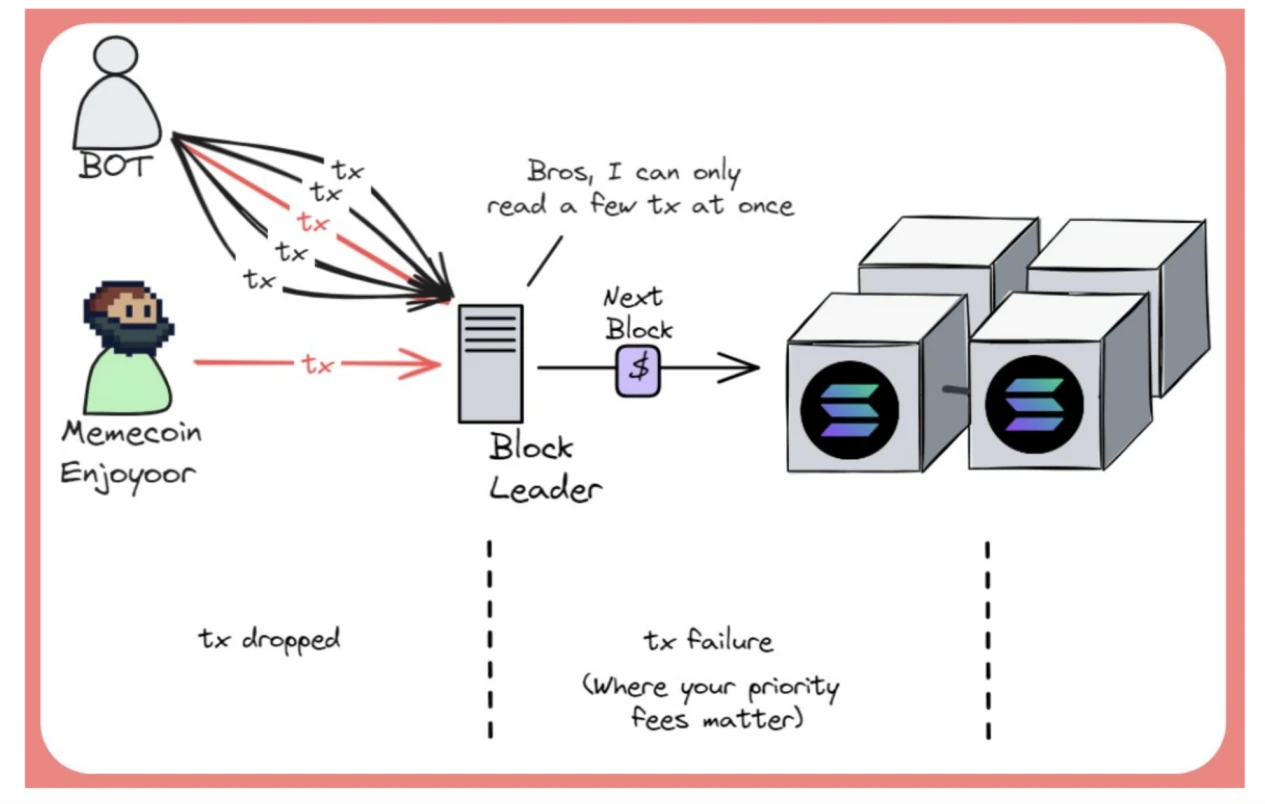
Diagram of Failed Transactions, Image Source: bread
The main reason for Solana's downtime is the use of the experimental application layer protocol QUIC, which utilizes UDP and multiplexing for fast transmission while aiming to maintain the integrity of data transmission. As a result, mechanisms are designed to retransmit lost packets in case of packet loss. When the Leader node receives multiple transactions, it opens multiple channels using the QUIC protocol. However, the Leader node is ultimately a computer with a limit on the transaction capacity it can handle. Therefore, when a large number of transactions flood in, the Leader node may cut off certain channel connections, leading to dropped transactions. There is no established standard for selecting which connections will be cut off (e.g., cutting off all connections with fees lower than xxx), and the decision to cut off connections is random. This creates a certain degree of opacity, and Leader nodes may be more inclined to prioritize profitable MEV transactions over low-value user transactions.
MEV
In Solana's block production mechanism, due to the direct interaction between RPC and the Leader using the FCFS principle, it does not have a Mempool similar to Ethereum's. With the presence of Mempool and Ethereum's permissionless principle, Ethereum faces a more severe MEV problem compared to Solana.
Jito Labs' client currently holds a 50% market share, and as a result, Jito Labs has built a pseudo-mempool. Users enter a pseudo-mempool through RPC and stay for about 200ms. Jito Labs provides an off-chain guarantee bundle to ensure that all transactions within the bundle are included in the block. Searchers can bid for the opportunity to sandwich attack pending transactions. Searchers bid for the bundle that maximizes profits, and then the Block Engine is responsible for finding the highest bidding bundle to submit to the Leader running the Jito Labs client.
This is the fundamental cause of MEV, but MEV has its positive externalities and demand. If Jito Labs does not create a pseudo-mempool, other projects will, so Jito Labs chooses to capture this market and improve the mechanism of MEV to mitigate negative externalities. However, this demand for MEV bots puts users at a disadvantage, as validators collect fees, MEV bots profit from arbitrage, and users face higher slippage and potential failed transactions.
State Growth
Solana's POH mechanism and Turbine consensus lead to oversized blocks, resulting in the problem of state growth. Currently, there is no exact answer to the ledger size, and the ledger is growing at a rate of one block every 450ms in a practical environment, approximately 4PB per year (running at maximum performance of 1GBPS). Currently, Solana's historical data is stored in the Google Bigtable database.
Solana's ledger data is not transparent, and the official team has not disclosed much about the potential impact of pursuing large block high TPS throughput and the resulting oversized blocks. The storage of the ledger also relies entirely on third parties, as the official team has found that centralized databases such as Google have higher performance than decentralized databases like Genesys Go and Arweave. These decentralized databases still face commercialization challenges. This rapid state growth and centralized hosting are among the criticisms of Solana.
Outlook
Solana has released its future roadmap, including:
Improving the token issuance protocol, including encrypted transfers, hooks, and metadata pointers.
Client improvements, including the lightweight client Tinydancer, transitional client Frankendancer, and ultimate client Firedancer.
Ecosystem development components: Gmaeshift focuses on game SDKs, armada markets focuses on improving the token lifecycle, SPE focuses on enterprise-level SVM blockchains, virtual machine improvements, etc.
We can see that Solana's POH algorithm and Turbine consensus prioritize blockchain performance in the trilemma, and the benefit is that it currently has the best performance in the environment, expanding the boundaries of exploratory applications. With Solana's strategic goal of consumer applications, there is a high possibility of sparking Mass Adoption applications. Additionally, projects on Solana have a weaker brand effect, providing more opportunities for entrepreneurs.
Solana's main advantages in ecosystem development lie in DePin/AI and Meme, but we can also see that its ecosystem development has not yet reached the expected level, and Consumer Apps still cannot be commercialized. In terms of competitors, there are rising stars like Base, whose financing amount and market share are rapidly increasing.
Solana also faces some technical issues, including downtime, transaction failures, MEV, rapid state growth, and centralization, which have been criticized. However, the positive aspect of Solana is that it does not focus on redundant infrastructure construction but rather relies on its current TPS capacity to build consumer applications, and its roadmap is centered around this. With more and more Layer2 constructions and client launches, the TPS of the SVM ecosystem will take a step forward. Solana is still an oasis with many ecosystem projects that have not been fully tapped by capital, offering many opportunities for exploration by entrepreneurs.
About Gate Ventures
Gate Ventures is the venture capital department of Gate.io, focusing on investments in decentralized infrastructure, ecosystems, and applications that will reshape the world in the Web 3.0 era. Gate Ventures collaborates with global industry leaders to empower teams and startups with innovative thinking and capabilities, redefining the interaction patterns of society and finance.
Website: https://ventures.gate.io/
Twitter: https://x.com/gate_ventures
Medium: https://medium.com/gate_ventures
免责声明:本文章仅代表作者个人观点,不代表本平台的立场和观点。本文章仅供信息分享,不构成对任何人的任何投资建议。用户与作者之间的任何争议,与本平台无关。如网页中刊载的文章或图片涉及侵权,请提供相关的权利证明和身份证明发送邮件到support@aicoin.com,本平台相关工作人员将会进行核查。




